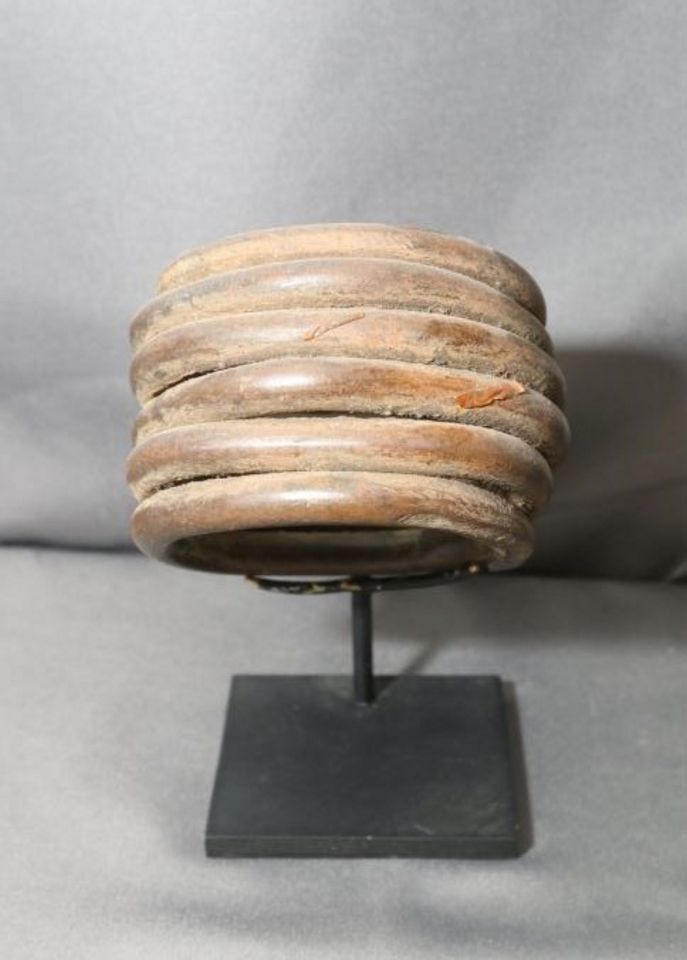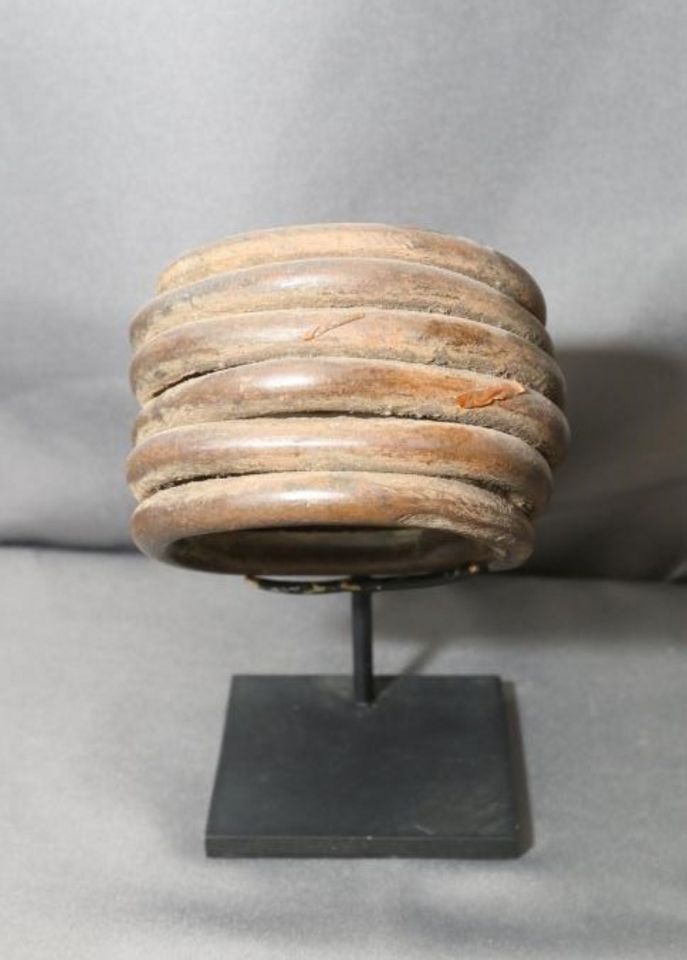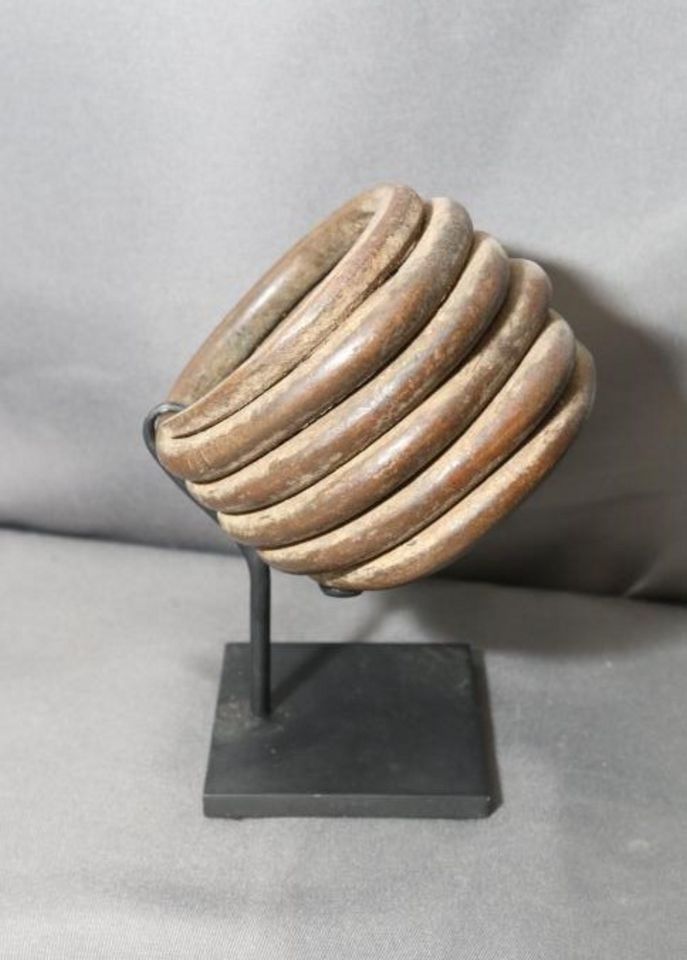Items located in Pleasant Valley, NY. Items include Asafo militia flag, Fante people, Ghana; gong rattle, Chamba people, Cameroon & Nigeria; blacksmith tools, Soninke people, Gambia; ceremonial fetish, Fon people; traditional women's hair pins, Bozo people, Mali; oil lamps, Dogon people, Mali; Cheetem rod currency, Anang people, Nigeria; wedding blanket, Fulani people, Mali or Niger; torque neck ring, Yoruba people, Nigeria; Cache Sexe ring, Kirdipeople, Cameroon & Northeast Nigeria; West African bells, Yoruba People, Nigeria; Duge necklaces, Dogon people, Mali and more.
AFRICAN ART COLLECTION OF MARY SUE AND PAUL PETER ROSEN
Mary Sue and Paul Peter Rosen have collected African art for over thirty years, making nine trips to Africa to study the art in its cultural setting. The Rosens have published three African art books, curated more than ten exhibitions from their collection, and have given public lectures about African art and culture. They have donated art from their collection to various institutions including the Newark Museum, Temple University in Philadelphia, the SMA Fathers African Art Museum in Tenafly, New Jersey, and the African American Research Library in Fort Lauderdale, Florida.
Payment is due by Friday, September 27 at 1PM.
Pickup in Pleasant Valley, NY must be completed by Friday, September 27 at 3PM.
All lots sold as is, where is. There is a 15% Buyers Premium for all lots purchased. Payment methods include cash, MC, Visa, Discover or good check. You can make credit card payment online by going to your Member Area and selecting your invoice.
*NOTE* Shipping is available on all items.
AFRICAN ART COLLECTION OF MARY SUE AND PAUL PETER ROSEN
Mary Sue and Paul Peter Rosen have collected African art for over thirty years, making nine trips to Africa to study the art in its cultural setting. The Rosens have published three African art books, curated more than ten exhibitions from their collection, and have given public lectures about African art and culture. They have donated art from their collection to various institutions including the Newark Museum, Temple University in Philadelphia, the SMA Fathers African Art Museum in Tenafly, New Jersey, and the African American Research Library in Fort Lauderdale, Florida.
Payment is due by Friday, September 27 at 1PM.
Pickup in Pleasant Valley, NY must be completed by Friday, September 27 at 3PM.
All lots sold as is, where is. There is a 15% Buyers Premium for all lots purchased. Payment methods include cash, MC, Visa, Discover or good check. You can make credit card payment online by going to your Member Area and selecting your invoice.
*NOTE* Shipping is available on all items.
Auction Info
Items located in Pleasant Valley, NY. Items include Asafo militia flag, Fante people, Ghana; gong rattle, Chamba people, Cameroon & Nigeria; blacksmith tools, Soninke people, Gambia; ceremonial fetish, Fon people; traditional women's hair pins, Bozo people, Mali; oil lamps, Dogon people, Mali; Cheetem rod currency, Anang people, Nigeria; wedding blanket, Fulani people, Mali or Niger; torque neck ring, Yoruba people, Nigeria; Cache Sexe ring, Kirdipeople, Cameroon & Northeast Nigeria; West African bells, Yoruba People, Nigeria; Duge necklaces, Dogon people, Mali and more.
AFRICAN ART COLLECTION OF MARY SUE AND PAUL PETER ROSEN
Mary Sue and Paul Peter Rosen have collected African art for over thirty years, making nine trips to Africa to study the art in its cultural setting. The Rosens have published three African art books, curated more than ten exhibitions from their collection, and have given public lectures about African art and culture. They have donated art from their collection to various institutions including the Newark Museum, Temple University in Philadelphia, the SMA Fathers African Art Museum in Tenafly, New Jersey, and the African American Research Library in Fort Lauderdale, Florida.
Payment is due by Friday, September 27 at 1PM.
Pickup in Pleasant Valley, NY must be completed by Friday, September 27 at 3PM.
All lots sold as is, where is. There is a 15% Buyers Premium for all lots purchased. Payment methods include cash, MC, Visa, Discover or good check. You can make credit card payment online by going to your Member Area and selecting your invoice.
*NOTE* Shipping is available on all items.
AFRICAN ART COLLECTION OF MARY SUE AND PAUL PETER ROSEN
Mary Sue and Paul Peter Rosen have collected African art for over thirty years, making nine trips to Africa to study the art in its cultural setting. The Rosens have published three African art books, curated more than ten exhibitions from their collection, and have given public lectures about African art and culture. They have donated art from their collection to various institutions including the Newark Museum, Temple University in Philadelphia, the SMA Fathers African Art Museum in Tenafly, New Jersey, and the African American Research Library in Fort Lauderdale, Florida.
Payment is due by Friday, September 27 at 1PM.
Pickup in Pleasant Valley, NY must be completed by Friday, September 27 at 3PM.
All lots sold as is, where is. There is a 15% Buyers Premium for all lots purchased. Payment methods include cash, MC, Visa, Discover or good check. You can make credit card payment online by going to your Member Area and selecting your invoice.
*NOTE* Shipping is available on all items.
Categories:
MITAKO COIL MANILLA CURRENCY. Teke people, Stanley Pool region of Congo. This region is rich in copper ore which was mined and smelted by the Teke people as early as the 18th century. The copper currency they created, called Ngiele, consisted of thin copper rods which were sometimes shaped into coils. British and French traders who entered this area in the mid-to-late 19th century offered this larger version, called mitako, which was the standard currency until the 1940s. The value of mitako varied with the thickness of the rod and ]number of coils. At one time, a male slave cost 600 mitako, a female slave 200 mitako, and an egg one mitako. Six coils of copper rod. H2. 25in Diameter 3. 25in.
More Details
MITAKO COIL MANILLA CURRENCY. Teke people, Stanley Pool region of Congo. This region is rich in copper ore which was mined and smelted by the Teke people as early as the 18th century. The copper currency they created, called Ngiele, consisted of thin copper rods which were sometimes shaped into coils. British and French traders who entered this area in the mid-to-late 19th century offered this larger version, called mitako, which was the standard currency until the 1940s. The value of mitako varied with the thickness of the rod and ]number of coils. At one time, a male slave cost 600 mitako, a female slave 200 mitako, and an egg one mitako. Six coils of copper rod. H2. 25in Diameter 3. 25in.
High Bid:
$60.00 – guyro
Auction Type: One Lot
Quantity: 1
Bidding has closed on this lot









